“When it becomes dominated by a collectivist creed, democracy will inevitably destroy itself.” — Fredrich August von Hayek
My last blog post was on September 18, 2013. Since that time I have written nothing due to a health issue that plagued my family. During the intervening months with the help of God and some good doctors the issue was resolved in a positive manner and all is good now. During this period most of my energy and thoughts were focused on getting my wife well so blog posting took a back seat for a while.
Also during this time we were scheduled to take a cruise to Australia and New Zealand in November. We did not take this cruise and were able to reschedule the same cruise, although a bit longer, for March of this year. For my first blog post since last September I want to talk about the cruise and the subsequent three extra days we spent in Australia. This will be lighter than delving eight into the culture and politics of the day, which seem to be getting worse during the hiatus of my writing.
The cruise was an 18 day journey with Royal Caribbean Cruise Line (RCCL) on the ship Voyager of the Seas which departed Sydney Harbor on March 9th. Due to the 19 hour time difference between Los Angeles and Sydney we departed LAX at 10:00 pm on March 6th and after a 15 hour flight we arrived in Sydney at 8:00 am on March 8th (Australian time). After a brief taxi ride to our hotel, the Radisson Blu in central Sydney we checked in and waited for my two daughters who were joining us albeit on a different flight from LAX. Finally when we all got together we ventured out for a walk about our area. The first this we encountered were blocked streets for a left-wing feminist march. If you are a past reader on my blog you know how I feel about left-wing protests. This particular parade was focused on allowing unlimited abortions, again which did not sit well with me. If this was my welcome to Australia I could not wait to get on the ship and hope for a change.
my two daughters who were joining us albeit on a different flight from LAX. Finally when we all got together we ventured out for a walk about our area. The first this we encountered were blocked streets for a left-wing feminist march. If you are a past reader on my blog you know how I feel about left-wing protests. This particular parade was focused on allowing unlimited abortions, again which did not sit well with me. If this was my welcome to Australia I could not wait to get on the ship and hope for a change.
The next day (Sunday) we were scheduled to board the ship at 3:00 pm so we had time to walk about Sydney Harbor (Darling Harbor) and take a tour of the famous Opera House. It was a gorgeous day and we had a nice lunch at a harbor-side restaurant. The tour of the Opera House was okay and I would give it a “B”. The problem was is that the tour guide was prone to give us 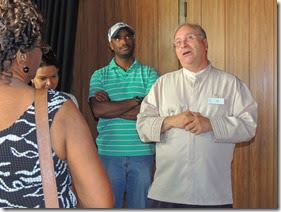 too much information (TMI), which made the tour a bit boring and too long. The Opera House itself was very interesting in its construction. The Sydney Opera House is a multi-venue performing arts center in Sydney. Designed by Danish architect Jørn Utzon, the facility formally opened on 20 October 1973 after a gestation beginning with Utzon's 1957 selection as winner of an international design competition. The NSW Government, led by Premier Joseph Cahill, authorized work to begin in 1958, with Utzon directing construction. The government's decision to build Utzon's design is often overshadowed by circumstances that followed, including cost and scheduling overruns as well as the architect's ultimate resignation. The cost was A$102 million, equivalent to ~A$859 million in 2012
too much information (TMI), which made the tour a bit boring and too long. The Opera House itself was very interesting in its construction. The Sydney Opera House is a multi-venue performing arts center in Sydney. Designed by Danish architect Jørn Utzon, the facility formally opened on 20 October 1973 after a gestation beginning with Utzon's 1957 selection as winner of an international design competition. The NSW Government, led by Premier Joseph Cahill, authorized work to begin in 1958, with Utzon directing construction. The government's decision to build Utzon's design is often overshadowed by circumstances that followed, including cost and scheduling overruns as well as the architect's ultimate resignation. The cost was A$102 million, equivalent to ~A$859 million in 2012
Though its name suggests a single venue, the project comprises multiple performance venues which together are among the busiest performing arts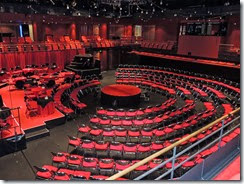 centers in the world — hosting over 1,500 performances each year attended by some 1.2 million people. The venues produce and present a wide range of in-house productions and accommodate numerous performing arts companies, including four key resident companies: Opera Australia, The Australian Ballet, the Sydney Theatre Company and the Sydney Symphony Orchestra. As one of the most popular visitor attractions in Australia, more than seven million people visit the site each year, with 300,000 people participating annually in a guided tour of the facility.
centers in the world — hosting over 1,500 performances each year attended by some 1.2 million people. The venues produce and present a wide range of in-house productions and accommodate numerous performing arts companies, including four key resident companies: Opera Australia, The Australian Ballet, the Sydney Theatre Company and the Sydney Symphony Orchestra. As one of the most popular visitor attractions in Australia, more than seven million people visit the site each year, with 300,000 people participating annually in a guided tour of the facility.
(Note: you can view a complete gallery of all of my photos from this trip at by clicking this Link:)
We finally boarded our cruise ship, The Voyager of the Seas. The Voyager when launched in 1999 was the largest cruise ship afloat at 137,276 tons displacement. Today it is surpassed by ships such as the Quantum of the Seas (167,800 tons), the Freedom of the Seas (160,000 tons) and the whopping Oasis and Allure of the Seas at 225,282 tons.
The Voyager is 1,020 feet from bow to stern with a beam of 127 feet. It has 15 decks rising to 207 feet above the keel It can make 23.7 knots (27.3 mph) while carrying a crew of 1,181 to serve 3,138 passengers. It’s quite a ship and as we discovered a bit too big for our tastes. I prefer the Radiance class. The Voyager is a Pacific and Asia based cruise ship for RCCL serving Australia, New Zealand, Singapore, and China.
15 decks rising to 207 feet above the keel It can make 23.7 knots (27.3 mph) while carrying a crew of 1,181 to serve 3,138 passengers. It’s quite a ship and as we discovered a bit too big for our tastes. I prefer the Radiance class. The Voyager is a Pacific and Asia based cruise ship for RCCL serving Australia, New Zealand, Singapore, and China.
The ship has the following amenities:
 An innovative feature of Voyager of the Seas, and another first, is the Royal Promenade: a marble floored street stretching just over 3/4 the length of the ship featuring shops and light dining venues. This area is the heart of the ship for evening activity, along with the three story high La Scala theatre in which some of the latest production technology is used to produce Broadway standard production shows at night.
An innovative feature of Voyager of the Seas, and another first, is the Royal Promenade: a marble floored street stretching just over 3/4 the length of the ship featuring shops and light dining venues. This area is the heart of the ship for evening activity, along with the three story high La Scala theatre in which some of the latest production technology is used to produce Broadway standard production shows at night.
All cabins on Voyager of the Seas feature in-suite bathrooms and an interactive television service, and most outward facing cabins on the upper decks feature balconies.
In May 2014, Voyager of the Seas is scheduled to receive "Royal Advantage" upgrades, which will include an outdoor movie screen, digital signage, ship-wide Wifi, new Concierge and Diamond lounges, and the changeover of the Cafe Promenade and Portofino restaurants to the Park Cafe and Giovanni's Table concepts first introduced on the Oasis-class cruise ships. During this refurbishment, the inline skating rink will be removed and replaced with a Flowrider surfing simulator.
After we departed Sydney we had three days of sailing to reach our first port of call – Auckland, New Zealand. During these three days we were able to learn the layout of the ship, rest up from any residual jet lag and visit the Shipshape Spa, which my daughters did frequently. I even got a facial and scalp massage which was great.
As we sailed along I got to know some of the passengers and other I did not want to know. The ship was not entirely full (2,900), there were ±1,500 Australians, ±500 Brits, ±350 Americans, and an assortment of other nationalities including one man from Chile (according to the cruise director). Many of the Aussies flew to Sydney from Perth on the other side of the country and would return via the ship as Perth was our final destination.
There were many seniors and handicapped people on the cruise. Sometimes I thought there were so many of those electric powered wheel chairs that the public areas needed traffic lights. They were also difficult to get in and out of the elevators for some of the less competent drivers. Walkers and canes were also plentiful. I did not make a count but I thought that at least 60% of the passengers were obese. It was mainly the overweight ones that were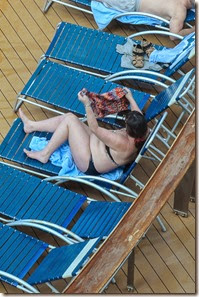 chow hounds at the Windjammer Café and were sometimes rude and obnoxious. They pushed in front as though the ship would run out of food. It was mainly the Aussies – especially the women. My wife and I are seniors but we don’t believe that status gives us any special privileges or an exemption from politeness.
chow hounds at the Windjammer Café and were sometimes rude and obnoxious. They pushed in front as though the ship would run out of food. It was mainly the Aussies – especially the women. My wife and I are seniors but we don’t believe that status gives us any special privileges or an exemption from politeness.
There is no smoking on the RCCL ships anymore unless in a designated area, not even the balconies of your suites. The designated areas are on the starboard sides of decks 4, 11, and 12. They used to have a lounge bar dedicated to cigar smokers where you could enjoy a good cigar and a Makers Mark or Jack Daniels after dinner. This is no longer the case with the Voyager. I missed this.
Our first port of call was Auckland New Zealand where we arrived at 07:12 am on the morning of March 13, 2014 as the sun was coming up. Auckland, located on the North Island of New Zealand, is the largest and most  populous urban area in the country. Auckland has a population of 1,418,000, which constitutes 32 percent of the country's population. It is part of the wider Auckland Region, which includes the rural areas and towns north and south of the urban area, plus the islands of the Hauraki Gulf. Auckland has the largest Polynesian population of any city in the world. In Māori, Auckland's name is Tāmaki Makaurau. While Auckland is the largest city in New Zealand it is not the capital. That honor is left to Wellington a city with 28% of Auckland’s population.
populous urban area in the country. Auckland has a population of 1,418,000, which constitutes 32 percent of the country's population. It is part of the wider Auckland Region, which includes the rural areas and towns north and south of the urban area, plus the islands of the Hauraki Gulf. Auckland has the largest Polynesian population of any city in the world. In Māori, Auckland's name is Tāmaki Makaurau. While Auckland is the largest city in New Zealand it is not the capital. That honor is left to Wellington a city with 28% of Auckland’s population.
Economic deregulation in the mid-1980s led to dramatic changes to Auckland's economy and many companies relocated their head offices from Wellington to Auckland. The region was now the nerve center of the national economy. Auckland also benefited from a surge in tourism, which brought 75% of New Zealand’s international visitors through its airport. In 2004, Auckland’s port handled 43% of the country’s container trade.
The face of urban Auckland changed when the government’s immigration policy began allowing immigrants from Asia in 1986. By 2006 the Asian population had reached 18.0% in Auckland, and 36.2% in the central city. New arrivals from Hong Kong, Taiwan and Korea gave a distinctive character to the areas where they clustered, while a range of other immigrants introduced mosques, temples, halal butchers and ethnic restaurants to the suburbs. The assertiveness of Pacific Island street culture and the increasing political clout of ethnic groups contribute to the city’s multiculturalism, something many native Kiwis aren’t too happy with.
In Auckland we took about a five hour panorama bus tour of the city. These bus tours are a good way to learn about the city as the driver is also the tour guide who spits out the facts as we motor along the city streets. Facts such as the cost of housing and gasoline. Petrol in New Zealand is very pricy. Gasoline is priced at NZ217.9 which indicates 217.9 cents or NZ$2.17 and 9/10 per liter. This works out to NZ$8.25 per gallon ($7.75 US). 65% is for taxes. $4.19 per gallon seems like a bargain at this rate. That’s why there are so many small Japanese and Korean cars on the streets although you will see big BMWs, Mercedes, and SUVs.
One of our stops was the Botanical Gardens which was a great photo opportunity and where learned about the Southern Hemisphere’s different flora. There we some very interesting plants, trees and flowers here flora not seen in the United States. On the way back to the ship we drove along the Auckland-Waiwera Motorway where we had a great view of the Auckland skyline with its The famous Sky Tower rising 328 meters (1,076 ft.) above the city. (As space on the blog page is limited I have included links to the various photos showing what is being described in the narrative.)
opportunity and where learned about the Southern Hemisphere’s different flora. There we some very interesting plants, trees and flowers here flora not seen in the United States. On the way back to the ship we drove along the Auckland-Waiwera Motorway where we had a great view of the Auckland skyline with its The famous Sky Tower rising 328 meters (1,076 ft.) above the city. (As space on the blog page is limited I have included links to the various photos showing what is being described in the narrative.)
All in Auckland certainly was a nice stop, especially after three days of sailing the Tasman Sea, where we got somewhat acquainted with the land of the Kiwis.
Our next port of call would be the town of Tauranga on the Bay of Plenty. Tauranga is the most populous city in the Bay of Plenty region of the North Island of New Zealand. Here we arrived at 07:45 on the morning of March 14th to the dawn of what looked to be another beautiful day.
Tauranga was settled by Māori late in the 13th century and by Europeans in the early 19th century and was constituted as a city in 1963. Tauranga City is the center of the sixth largest urban area in New Zealand, with an urban population of 123,500.
The city lies in the north-western corner of the Bay of Plenty, on the south-eastern edge of Tauranga Harbor. The city expands over an area of 168 square kilometers (65 sq. mi). The city is one of New Zealand's main centers for business, international trade, culture, fashion and horticultural science. The Port of Tauranga is New Zealand's largest port in terms of gross export tonnage and efficiency. Tauranga is one of New Zealand's fastest growing cities, with a 14 percent increase in population between the 2001 census and the 2006 census. Though that number has slowed to 11% between the 2006 Census and the 2013 Census. This sudden population growth has made Tauranga New Zealand's 5th largest city.
Our shore excursion in Tauranga was one of the best of the cruise as we headed out for a kiwi orchard. Not knowing much about kiwis except they are an exotic green fruit found in fruit salads I was excited about this tour.
We arrived at the Kiwi 360 Orchard near the town of Paengaroa and were greeted by the owner of the orchard who guided us around the orchard and told us more than we probably ever wanted to know about kiwis – but unlike the TMI Sydney Opera tour this was not boring and it was fun to learn about this amazing fruit.
The kiwifruit or Chinese gooseberry (often shortened to kiwi outside New Zealand), is the edible berry of a woody vine in the genus Actinidia. The fruit has a soft texture and a sweet but unique flavor, and today is a commercial![Over 70% of kiwi production is in Italy, New Zealand, and Chile. Italy produces roughly 10% more kiwifruit than New Zealand, and Chile produces 40% less.[3] With these three main production centers, kiwifruit is produced for worldwide consumption roughly all year long Over 70% of kiwi production is in Italy, New Zealand, and Chile. Italy produces roughly 10% more kiwifruit than New Zealand, and Chile produces 40% less.[3] With these three main production centers, kiwifruit is produced for worldwide consumption roughly all year long](http://lh3.ggpht.com/-JoFoEQrA7S0/U1dT39xwARI/AAAAAAAAFF0/G0R60F7An1w/FXP_9213%25255B5%25255D.jpg?imgmax=800) crop in several countries, such as Italy, New Zealand, Chile, Greece, and France. Kiwifruit is a rich source of vitamin C (1.5 times the United States DRI per 100 grams) and vitamin K, and a good source of dietary fiber and vitamin E. The fruit and skin contain flavonoids, actinidain, and adhered pollen, which may produce irritation in the mouth and throat of some allergic individuals.
crop in several countries, such as Italy, New Zealand, Chile, Greece, and France. Kiwifruit is a rich source of vitamin C (1.5 times the United States DRI per 100 grams) and vitamin K, and a good source of dietary fiber and vitamin E. The fruit and skin contain flavonoids, actinidain, and adhered pollen, which may produce irritation in the mouth and throat of some allergic individuals.
Over 70% of kiwi production is in Italy, New Zealand, and Chile. Italy produces roughly 10% more kiwifruit than New Zealand, and Chile produces 40% less. With these three main production centers, kiwifruit is produced for worldwide consumption roughly all year long.
New Zealand ranks second to Italy in the production of Kiwifruit at 376,400 tons per year. Italy produces 384,800 tons. The United States ranks 9th at 26,000 tons.
Pseudomonas syringae actinidiae (PSA) was first identified in Japan in the 1980s. This bacterial strain has been controlled and managed successfully in orchards in Asia. In 1992, it was found in northern Italy. In 2007/2008, economic losses were observed, as a more virulent strain became more dominant (PSA V). In 2010 it was found in New Zealand's Bay of Plenty kiwifruit orchards in the North Island.
Here is something I found interesting and refreshing about New Zealand. During the months of April and May (autumn in New Zealand) it takes 25,000 people to harvest the kiwi crop. To accomplish this feat the New Zealand farmers import temporary workers from Indonesia, Fiji, Thailand, and the Philippines. The pay is $17 per hour and when the harvest is over the temporary workers go home. Also, any NZ citizen on welfare is required to work in the harvest or their welfare payments will be suspended. This should be the policy in states like California, Arizona, and Washington where there are large fruit orchards to be harvested. It makes sense to me.
After the tour of the orchard and briefing on the kiwi we were whisked back to the entrance where the little café and general store is located. Here we had a delicious glass of cold, pure kiwi juice and a little cake with kiwi icing. After hiking around the orchard this was a welcome break and the juice was really refreshing.
to the entrance where the little café and general store is located. Here we had a delicious glass of cold, pure kiwi juice and a little cake with kiwi icing. After hiking around the orchard this was a welcome break and the juice was really refreshing.
The my wife and daughters browsed the general store where you could buy anything kiwi from juice, wine (yes wine), and candy to medicinal products like hand and face cream along with a variety of stuffed animals and T-shirts. Of course my wife bought some kiwi wine and some kiwi candy. There is nothing like visiting an orchard on a sunny day.
On the way back to the ship there was a brief stop at the historic Elms House. A family home for 150 years, the mission house is now a museum, showcasing the lives of the three generations who lived within its walls. The house was lived in from 1847 to 1992. The contents reflect the lives of all the occupants. The name was changed to The Elms in 1873, when active mission work ceased. This was a so so tour so I eschewed much of the tour and lecture and spent time taking photos of the residential neighborhood and chatting with the bus driver getting the low-down on the economics, culture, and politics of New Zealand.
Upon return to the ship we were in time for a brief nap and our daily afternoon trivia game where we battled the intense Aussies for the correct answers to twenty general questions from history and geography to movies and pop culture. It was amazing how the Aussies and Brits would challenge the quiz master over the answers. Of course the quiz rules were that the quiz master’s answers were correct. We never got a score higher than 16 with an average of about 11. It was social and fun. Not all of these intense seniors took it that way.
After another full day and night of sailing we reached the port city of Napier on March 15th. Our first sight of Napier was the quays stacked with lumber waiting to be on loaded for shipment to Japan and containers for shipment world-wide.
Napier is the nexus of the largest wool center in the Southern Hemisphere, and it has the primary export seaport for northeastern New Zealand – which is the largest producer of apples, pears, and stone fruit in New Zealand.
On 3 February 1931, most of Napier was leveled by an earthquake. The collapses of buildings and the ensuing fires killed 256 people. The center of the town was destroyed by the earthquake, and later rebuilt in the Art Deco style popular at that time. Some 4000 hectares (15.4 sq. miles) of today's Napier were undersea before the earthquake raised it above sea level. The earthquake uplifted an area of 1500 km2 (580 sq. miles) with a maximum of 2.7 m of uplift.
The two places we visited on our shore excursion into Napier was the National Aquarium of New Zealand and the Church Road Winery. Both were mediocre at best. The so-called National Aquarium was about one-fifth the size of the Long Beach Aquarium. The exhibits were small as were the selections of aquatic life. It did, however give an opportunity to get a $5 dollar cup of coffee and take some photos of the surrounding residential and commercial areas.
The winery was not much better and I found the wine to be sub-par and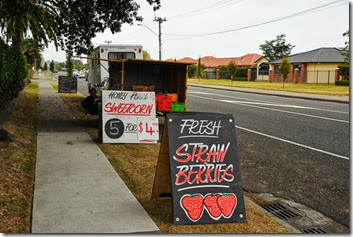 overpriced. It did, however, have a nice little café where you could get a glass of wine and a sandwich. I passed on the tour of the winery as living in the Temecula wine country of Southern California I have seen about all of the wineries I ever need to see. Instead I chatted with the street vendor at his fruit and strawberry stand learning more about New Zealand.
overpriced. It did, however, have a nice little café where you could get a glass of wine and a sandwich. I passed on the tour of the winery as living in the Temecula wine country of Southern California I have seen about all of the wineries I ever need to see. Instead I chatted with the street vendor at his fruit and strawberry stand learning more about New Zealand.
The most interesting sight in Napier was the display of classic cars waiting for us at the dock. While Napier may be an important port city for New Zealand it has its limitations as a tourist location.
The next day was an at-sea day allowing us to catch up on some sleep and some on-board shopping on the Promenade Deck. People love to shop on these cruise ships. They can buy almost anything except food. The big items 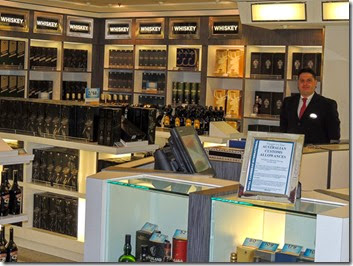 are the watches, jewelry, and liquor. The liquor is stated to be duty free, but the prices, even with no tax, are much higher than I can get it for at BevMo or Costco. All prices on the ship are in US Dollars and you do not pay for anything at the point of sale. You merely present you sign and sail pass and sign the sales chit. When the cruise is over and you are ready to leave all of the monies you spent for drinks, special food, and goodies are charged to your credit card. It’s the day of reckoning. It’s amazing how much of bill you can run up without realizing it. All food with the exception of the high end special restaurants like the Portofino are free and a part of your cruise package. Coffee, tea, lemonade, and breakfast juices are also free. Soft drinks, wine, beer, spirits, and bar drinks are extra. Speaking of food and eating a nice place for a lunch sandwich or pizza is the Café on the Promenade Deck. You can get a great selection of beers at the Pig and Whistle Pub, but no Shepard’s Pie or Bangers, Beans, and Mash.
are the watches, jewelry, and liquor. The liquor is stated to be duty free, but the prices, even with no tax, are much higher than I can get it for at BevMo or Costco. All prices on the ship are in US Dollars and you do not pay for anything at the point of sale. You merely present you sign and sail pass and sign the sales chit. When the cruise is over and you are ready to leave all of the monies you spent for drinks, special food, and goodies are charged to your credit card. It’s the day of reckoning. It’s amazing how much of bill you can run up without realizing it. All food with the exception of the high end special restaurants like the Portofino are free and a part of your cruise package. Coffee, tea, lemonade, and breakfast juices are also free. Soft drinks, wine, beer, spirits, and bar drinks are extra. Speaking of food and eating a nice place for a lunch sandwich or pizza is the Café on the Promenade Deck. You can get a great selection of beers at the Pig and Whistle Pub, but no Shepard’s Pie or Bangers, Beans, and Mash.
It was fun to watch people on these at-sea days flock around the sales counters and stores looking for bargains. They pick and discard and the sales staff is constantly tidying up he counters. It’s like bargain day at Kohl’s. Some people just have no manners.
It should be noted that as the cruise progresses the discounts increase as the sales staff is mandated to get rid of as much of the stuff as they can. At the end of the cruise I bought a nifty watch for $27.00 that included a pair of sunglasses. You can also purchase digital cameras, binoculars, and walkie-talkie radios on-board. These items are not discounted.
After leaving Auckland we were racing against Cyclone Lucy a nasty storm that could play havoc with our cruise. This photo shows us at 42°30'10" S 175°2'54" E we are 80 miles south of Wellington (the capital) and 70 due east of the coast of New Zealand. The depth of the sea here is 5,300 and the swells are 6 to 8 meters with the wind at 35 knots. We are in for a bumpy ride and deck 11 was deserted. We were not so much fearful for the ship but for the heavy rains that might interfere with our day excursion to the penguin refuge in Dunedin.
After our at-sea day we reached Dunedin our last port of call in New Zealand. This is where we would be off to see the penguin refuge called “Penguin Place.” This is one of the excursions we were looking forward to and we were not disappointed. We not only saw many penguins we also learned quite a bit about these interesting flightless birds.
Dunedin is the second-largest city on the South Island of New Zealand, and the principal city of the Otago Region. While Tauranga, Napier-Hastings and Hamilton have eclipsed the city in population in recent years to make it only the seventh largest city in New Zealand, Dunedin is still considered to be one of the four main cities of New Zealand for historic, cultural, and geographic reasons. Dunedin was the largest city by territorial land area until superseded by Auckland on the creation of the Auckland Council in November 2010. Dunedin was the largest city in New Zealand by population until about 1900. The city population at 5 March 2013 was 120,246. The Dunedin urban area lies on the central-eastern coast of Otago, surrounding the head of Otago Harbor. The harbor and hills around Dunedin are the remnants of an extinct volcano. The city suburbs extend out into the surrounding valleys and hills, onto the isthmus of the Otago Peninsula, and along the shores of the Otago Harbor and the Pacific Ocean.
The city's largest industry is tertiary education – Dunedin is home to the University of Otago, New Zealand's first university (1869), and the Otago Polytechnic. Students account for a large proportion of the population; 21.6 percent of the city's population was aged between 15 and 24 at the 2006 census, compared to the New Zealand average of 14.2 percent
Our first view of Dunedin was the port with its numerous containers and stacks of timber ready to be exported. Once again we can see that New Zealand’s vast resources of timber are ready to feed the mills of Japan.
Our bus tour to the penguin refuge began on an ominous note when our bus broke down. It took the tour company about twenty minutes to get us a new bus and on our way again. Our first stop was at the so-called steepest street in the world. Once each year this street is closed off to traffic and contestants race unmanned model cars down the street to see whose cars can go the farthest and the fastest. It must be great fun for the residents but I sure would hate to walk it every day.
Finally we reached the Penguin Place and began to see and learn about these goofy but popular flightless birds.(The resting penguin)
There are 17-19 different species of penguins. I do not know the species of these flightless birds at the Penguin Place so you can make your best guess if you are a penguin aficionado.
Penguins are very social animals and live well in colonies. They also care for their young as a family. Highly adapted for life in the water, penguins have counter shaded dark and white plumage, and their wings have evolved into flippers. Most penguins feed on krill, fish, squid and other forms of sea life caught while swimming underwater. They spend about half of their lives on land and half in the oceans.
Diving penguins reach 6 to 12 km/h (3.7 to 7.5 mph), though there are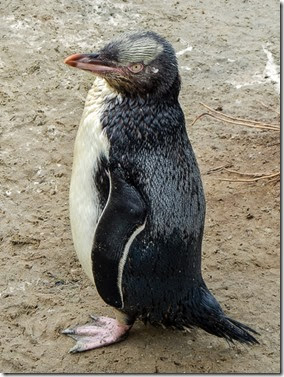 reports of velocities of 27 km/h (17 mph) (which are more realistic in the case of startled flight. The small penguins do not usually dive deep; they catch their prey near the surface in dives that normally last only one or two minutes. Larger penguins can dive deep in case of need. Dives of the large Emperor Penguin have been recorded reaching a depth of 565 m (1,854 ft.) for up to 22 minutes.
reports of velocities of 27 km/h (17 mph) (which are more realistic in the case of startled flight. The small penguins do not usually dive deep; they catch their prey near the surface in dives that normally last only one or two minutes. Larger penguins can dive deep in case of need. Dives of the large Emperor Penguin have been recorded reaching a depth of 565 m (1,854 ft.) for up to 22 minutes.
Two of the interesting things we saw were the little hutches where mother penguins hatched and nursed their young and the molting of the penguins. Both were sights I had not seen in any zoo. The Penguin Place was a very worthwhile shore excursion.
Now we in for some at-sea days as we cruised the New Zealand Fjord Area through Dusky, Doubtful and Milford Sounds on the west side of the south island. This took most of the day as our ship’s captain navigated through the tricky waters of these sounds. It was a beautiful day with clear blue skies. It was a great for photos. Fortunately I had my Nikon D700 equipped a GPS geo-tagging unit which imbedded the latitude, longitude, and elevation into the metadata of the digital image. This allowed me to precisely located where and in which sound I took the picture. I have been using this device for over five years and all of my travel photos are geo-tagged so I can locate where I took the photo upon my return home.
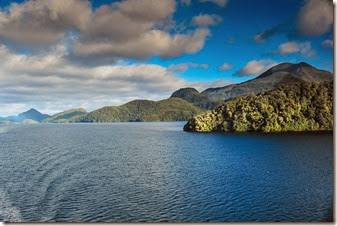 After leaving the Fjords of New Zealand we headed due west once again across the Tasman Sea towards Melbourne Australia. To reach Melbourne would require 3 at-sea days where we would have nothing much to do except relax, eat, and shop. The relaxing part was okay but I was not enchanted with the eating and shopping part. Most people gain at least 5 pounds on a cruise like this. I was very careful as to what and how much I ate and was fortunate not gain any weight at all.
After leaving the Fjords of New Zealand we headed due west once again across the Tasman Sea towards Melbourne Australia. To reach Melbourne would require 3 at-sea days where we would have nothing much to do except relax, eat, and shop. The relaxing part was okay but I was not enchanted with the eating and shopping part. Most people gain at least 5 pounds on a cruise like this. I was very careful as to what and how much I ate and was fortunate not gain any weight at all.
Part of this fact was due to my discipline and part due to the quality of the food. The food for the dinners in the main dining room was pretty good and the portions were reasonable. On the other hand the food in the Windjammer and Islands cafes was not as good or as varied as other cruises on other ships. There was the same cuisine every day and much of it was not very appetizing to me. On other cruises there were days when local or regional foods would be served. As examples on our Panama Canal cruise there were days when there would be a taco bar and Mexican or Central American food served. On our Aegean Sea cruise there was a good selection of Mediterranean foods including eggplant parmesan and good salads. On this cruise there was no such variety.
With the exception of breakfast we did not eat that much in these cafes. Also I did not care for the rudeness of many of the seniors as they filled their plates as though it was their last meal on earth. They would then return to their tables with their plates heaping with food and end up leaving half of it on their plate. The waste on these ships is unbelievable.
During our 3 days at-sea I felt we were getting a dose of cabin fever. I think a cruise of 18 days is too long. Of these 18 days 11 would be at-sea or cruising days. This is just too long.
We reached the Port of Melbourne at 08:00 on March 21st as dawn was breaking. We were certainly ready to get off the ship and see the sights of Melbourne.
Melbourne is the capital and most populous city in the state of Victoria, and the second most populous city in Australia behind Sydney The name "Melbourne" refers to an urban agglomeration area (and census statistical division) spanning 9,900 km2 (3,857.2 sq mi) that comprises the greater metropolis – as well as being a common name for its metropolitan hub, the Melbourne City Centre. It is a leading financial center in Australia, as well as the Asia-Pacific region, and has been ranked the world's most livable city since 2011 (and among the top three since 2002), according the Economist Intelligence Unit (EIU). In 2013 the EIU also ranked Melbourne the fourth most expensive city in the world, tying with Oslo, Norway. Melbourne is rated highly in the areas of education, entertainment, healthcare, research and development, tourism and sports.
It is located on the large natural bay of Port Phillip, with its City Center situated at the northernmost point of the bay – near to the estuary of the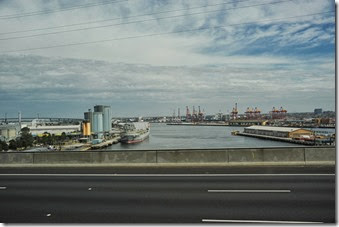 Yarra River. The metropolitan area extends south from the City Center, along the eastern and western shorelines of Port Phillip, and expands into the hinterlands – toward the Dandenong and Macedon mountain ranges, Mornington Peninsula and Yarra Valley. The City Centre is located in the municipality known as the City of Melbourne, and the metropolis consists of a further 30 municipalities. Melbourne has a population of 4.35 million, and the fastest growing population among Australian capital cities. The inhabitants of the city are called Melburnians.
Yarra River. The metropolitan area extends south from the City Center, along the eastern and western shorelines of Port Phillip, and expands into the hinterlands – toward the Dandenong and Macedon mountain ranges, Mornington Peninsula and Yarra Valley. The City Centre is located in the municipality known as the City of Melbourne, and the metropolis consists of a further 30 municipalities. Melbourne has a population of 4.35 million, and the fastest growing population among Australian capital cities. The inhabitants of the city are called Melburnians.
Founded on 30 August 1835 (in what was then the Colony of New South Wales), by settlers from Launceston in Van Diemen's Land, it was incorporated as a Crown settlement in 1837. It was named "Melbourne" by the Governor of New South Wales, Sir Richard Bourke, in honor of the British Prime Minister of the day, William Lamb, 2nd Viscount Melbourne. It was declared a city by Queen Victoria in 1847, before becoming the capital city of the newly created Colony of Victoria in 1851. During the Victorian gold rush of the 1850s, it was transformed into one of the world's largest and wealthiest cities. After the federation of Australia in 1901, Melbourne served as the interim seat of government for the newly created nation of Australia until 1927 when it was moved to Canberra.
The shore excursion we all wanted to take was the one to the Queen Victoria Market. The Queen Victoria Market (also known as the Queen Vic Markets or the Queen Vic, and locally as '"Vic Market"') is a major landmark in Melbourne, Australia, and at around seven hectares (17 acres) is the largest open air market in the Southern Hemisphere.
The Market is significant to Melbourne's culture and heritage and has been listed on the Victorian Heritage Register. The Market is named after Queen Victoria who ruled the British Empire, from 1837 to 1901.
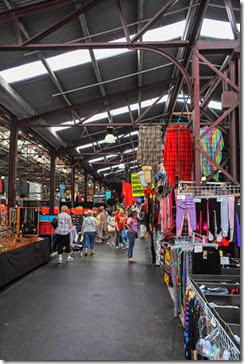 The Queen Victoria Market is the only surviving 19th century market in the Melbourne central business district. There were once three major markets in the Melbourne CBD, but two of them, the Eastern Market and Western Market, both opened before the Queen Victoria, closed in the 1960s. It also forms part of an important collection of surviving Victorian markets which includes the inner suburban Prahran Market and South Melbourne Market.
The Queen Victoria Market is the only surviving 19th century market in the Melbourne central business district. There were once three major markets in the Melbourne CBD, but two of them, the Eastern Market and Western Market, both opened before the Queen Victoria, closed in the 1960s. It also forms part of an important collection of surviving Victorian markets which includes the inner suburban Prahran Market and South Melbourne Market.
The Market is open every day of the week except Mondays and Wednesdays. On Wednesday evenings in the summer months, there is a night market which offers dining, bars, live entertainment and a variety of other stalls.
In January 2010, the Herald Sun reported that city planners wanted to transform the market into a "gourmet hub" by introducing upmarket food stalls. Lord Mayor Robert Doyle said he brought up the idea after visiting London's Borough Market, which has a "boutique" feel that could work in Melbourne.
In 1950 an American came to Australia, bought a used bus and opened an “American” doughnut wagon. They sell only plain glazed hot doughnuts. No chocolate covered or jelly filled. Of course we bought some of these delicious and unhealthy doughnuts. They were a great relief after the food we were getting on the boat. They were good.
I could not decide it the Queen Victoria Market was a giant flea mart, a swap meet, a farmers market, or just a giant general purpose shopping mall. You can bay almost anything here from clothing, souvenirs, leather goods, and jewelry to meat, fresh vegetables, bakery, and flowers. It’s quite a place!
We had a great time at the Queen Vic Market in Melbourne and it was certainly worth the time and money we spent for it. If I were choosing a city in Australia to reside in I would pick Melbourne as my second choice with Cairns being my number one. More about Cairns (pronounced “CANS” like tin cans).
Our next and last port of call before disembarking in Perth was Adelaide. We arrived at the Port of Adelaide at 09:00 on the morning of March 23rd and were greeted by a cloudy, overcast day and thousands of new vehicles parked at the dock.
One of the interesting features at the Port of Adelaide was all of the new Japanese and Korean automobiles and trucks parked at the docks and ready to be loaded on to carriers for transport to dealers in South Australia. It appears that the Aussies want larger cars, SUVs, and more pickup trucks than their neighbors in New Zealand even with the price of gasoline being about the same. Of course there are much greater distances to travel in Australia and if you want to traverse any portion of the outback you want a tough vehicle that can take some punishment and carry some stuff. Also if you don’t believe that the most popular color for cars, SUVs, and pickup trucks around the world is white or a shade of silver just take a look at the photos of these vehicles.
Adelaide is the capital city of South Australia and the fifth-largest city in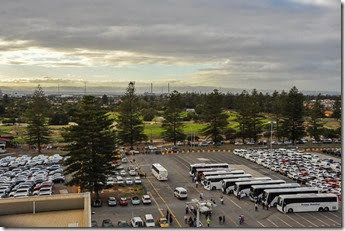 Australia. As at June 2013, Adelaide had an estimated resident population of 1.29 million. The demonym "Adelaidean" is used in reference to the city and its residents. Adelaide is north of the Fleurieu Peninsula, on the Adelaide Plains between the Gulf St Vincent and the low-lying Mount Lofty Ranges which surround the city. Adelaide stretches 20 km (12 mi) from the coast to the foothills, and 90 km (56 mi) from Gawler at its northern extent to Sellicks Beach in the south.
Australia. As at June 2013, Adelaide had an estimated resident population of 1.29 million. The demonym "Adelaidean" is used in reference to the city and its residents. Adelaide is north of the Fleurieu Peninsula, on the Adelaide Plains between the Gulf St Vincent and the low-lying Mount Lofty Ranges which surround the city. Adelaide stretches 20 km (12 mi) from the coast to the foothills, and 90 km (56 mi) from Gawler at its northern extent to Sellicks Beach in the south.
Named in honor of Adelaide of Saxe-Meiningen, queen consort to King William IV, the city was founded in 1836 as the planned capital for a freely settled British province in Australia. Colonel William Light, one of Adelaide's founding fathers, designed the city and chose its location close to the River Torrens, in the area originally inhabited by the Kaurna people. Light's design set out Adelaide in a grid layout, interspaced by wide boulevards and large public squares, and entirely surrounded by parklands. Early Adelaide was shaped by religious freedom and a commitment to political “progressivism” and civil liberties, which led to the moniker "City of Churches". The churches and civil liberties are okay, but they can keep their political progressivism.
As South Australia's seat of government and commercial center, Adelaide is the site of many governmental and financial institutions. Most of these are concentrated in the city center along the cultural boulevard of North Terrace, King William Street and in various districts of the metropolitan area. Today, Adelaide is noted for its many festivals and sporting events, its food and wine, its long beachfronts, and its large defense and manufacturing sectors. It ranks highly in terms of livability, being listed in the Top 10 of The Economist's World's Most Livable Cities index in 2010, 2011 and 2012. It was also ranked the most livable city in Australia by the Property Council of Australia in 2011 and again in 2013.
Australia is a goofy place when it comes to knowing the time wherever you are. There are four time zones across the country and each political division elects whether or not to accept daylight savings time. Adelaide is one-half hour behind Melbourne and 1½ hours ahead of Perth. If you don’t have a cell phone that gets the time from the local mobile network you may have a difficult time keeping up with the time as you travel about. It’s also a good idea to have one of digital watches, like a Casio, where you can quickly change the time by scrolling through the list of cities and airport codes. (Note the caption on the photo link here).
We had two targets for our shore excursion in Adelaide; the Cleland Wildlife Park and the Mount Lofty Summit and were hoping the rain would hold off my daughters had been looking forward to petting and feeding wallabies and having their picture taken holding a Koala.
After a boring and too long bus tour of central Adelaide, which reduced the time we have to spend at the wildlife park, we arrived at the park at 11:42 am on a partly cloudy day.
Cleland Wildlife Park has been a major tourist attraction in South Australia since 1967. Nestled within the natural bush setting of Cleland Conservation Park, and adjacent to Mount Lofty Summit, the park provides 35 hectares (86 acres) of open bush land habitat where visitors can interact with Australian wildlife. As we raced to get in line for the koala photos the first animal we passed was a Tasmanian devil. This crazy little creature kept racing around its enclosure like a wild person.
The koala (Phascolarctos cinereus or, inaccurately, koala bear is an arboreal herbivorous marsupial native to Australia. It is the only surviving representative of the family Phascolarctidae, and its closest living relatives are the wombats.
Koalas typically inhabit open eucalypt woodlands, and the leaves of these trees make up most of their diet. Because this eucalypt diet has limited nutritional and caloric content, koalas are largely sedentary and sleep for up to 20 hours a day
Being marsupials, koalas give birth to underdeveloped young that crawl into their mothers' pouches, where they stay for the first six to seven months of their life. These young koalas are known as joeys.
The koala has a body length of 60–85 cm (24–33 in) and weighs 4–15 kg (9– 33 lb). Their color ranges from silver grey to chocolate brown. Koalas from the northern populations are typically smaller and lighter in color than their counterparts further south. It is possible that these populations are separate subspecies, but this is disputed.
33 lb). Their color ranges from silver grey to chocolate brown. Koalas from the northern populations are typically smaller and lighter in color than their counterparts further south. It is possible that these populations are separate subspecies, but this is disputed.
The Australian government lists populations in Queensland and New South Wales as Vulnerable. The animal was hunted heavily in the early 20th century for its fur, and large-scale culling in Queensland resulted in a public outcry that initiated a movement to protect the species. Sanctuaries were established, and translocation efforts moved to new regions koalas whose habitat had become fragmented or reduced. The biggest threat to their existence is habitat destruction caused by agriculture and urbanization.
Koalas may live from 13 to 18 years in the wild. While female koalas usually live this long, males may die sooner because of their more hazardous life. Koalas usually survive falls from trees and immediately climb back up, but injuries and deaths from falls do occur, particularly in inexperienced young and fighting males. At around six years of age, the koala's chewing teeth begin to wear down and their chewing efficiency decreases. Eventually, the cusps will disappear completely and the animal will die of starvation.
After a wait of about 20 minutes and the change of two koalas (they got tired of all the handling) my daughters finally got the photo(s) they had been waiting for. One again the rudeness of the senior Australians raised its ugly head. As my daughters reached the girl of set up the photos I politely asked a woman standing in line if I could cut in a snap a few quick photos of them with the koala. This woman looked at me as though I had asked her for one her molars and accused me trying to cut in line ahead of her. Fortunately the girl handling the koala took my daughters Nikon and took the photos. The lack of class and civility of some people.
As it began to shower we walked over to the dingo enclosure. Dingos look like cute dogs, but they are far from it. The dingo (Canis lupus dingo) is a free-ranging dog found mainly in Australia, as well as Southeast Asia, where it is said to have originated. It is currently classified as a subspecies of the grey wolf, Canis lupus.
The dingo is the largest terrestrial predator in Australia, and plays an important role as an apex predator. However, the dingo is seen as a pest by sheep farmers due to attacks on livestock. Conversely, their predation on rabbits, kangaroos and rats is of benefit to cattle stations.
Some of the early European settlers looked on dingoes as domestic dogs, while others thought they were more like wolves. Over the years, dingoes began to attack sheep, and their relationship to the Europeans changed very quickly: they were regarded as devious and cowardly, since they did not fight bravely in the eyes of the Europeans, and vanished into the bush. Dingoes were seen as predators that killed wantonly, rather than out of hunger (similar claims are made today concerning dingo-hybrids).
While Dingos looks like Fido, the family pet, it is not. It is a predator that cannot be tamed or domesticated. Don’t pet the dingo. When I got home I had to watch the film “A Cry In The Dark” starring Meryl Streep and Sam Neill. It’s a film based on the 1980 case of a woman claiming that a dingo snuck into their tent by Ayres Rock and dragged her three-month old baby off into the outback. This was no doubt the biggest black mark on the Australian justice system and scandalous behavior of the news media in the history of the country. It is still a controversial subject even after Lindy Chamberlain was completely exonerated 32 years later in 2012.
We reached the area where the wallabies and emus were and he fun began with the petting and feeding of these kangaroo look-alike except they are much smaller and less aggressive. Aussies have been known to keep a wallaby for a pet.
with the petting and feeding of these kangaroo look-alike except they are much smaller and less aggressive. Aussies have been known to keep a wallaby for a pet.
Wallabies are herbivores whose diet consists of a wide range of grasses, vegetables, leaves, and other foliage. Due to recent urbanization, many wallabies now feed in rural and urban areas. Wallabies cover vast distances for food and water, which is often scarce in their environment. Mobs of wallabies often congregate around the same water hole during the dry season.
Adult male wallabies are referred to as "bucks", "boomers", or "jacks". An adult female wallaby is known as a "doe", "flyer", or "jill". Like the Kangaroo a young wallaby is called a “joey.” A group of wallabies is called a "court", "mob", or "troupe". Although members of most wallaby species are small, some can grow up to six feet in length (from head to tail). There was one jill nursing her joey without a care in the world of the people around her and the baby.
As the rain continued and it got colder we made our way to Mount Lofty Summit. Mount Lofty, 34°58′S 138°42′E, elevation 727 meters (2,385 ft.) is the highest point in the southern Mount Lofty Ranges. It is located about 15 km east of the center of the city of Adelaide in South Australia, and has panoramic views of the city and the Adelaide plains to the west, and of the Piccadilly Valley to the east. It was first climbed by a European when explorer Collet Barker climbed it in April 1831, almost seven years before Adelaide was settled. It was named by Matthew Flinders on 23 February 1802 during his circumnavigation of Australia.
The Summit was closed to the public during the Second World War, when the obelisk was considered an indispensable navigation assistant. A flashing strobe was fitted to the top to improve visibility at night. This strobe was removed after the war, but then re-installed in the 1990s, when the obelisk was repainted and restored during construction of the new kiosk. The Finders’ Obelisk is in honor of Mathew Finders who first sailed into Adelaide.
Light snowfalls are not uncommon on the summit, although it is possible for Mount Lofty to go two or three years without any snowfall. Mount Lofty is the coldest location in Adelaide, during winter months the temperature will not surpass 3-4 degrees Celsius (37-39 F) some days. It is the most common location for snow in South Australia, with other rare snowfalls in other parts of the Mount Lofty Ranges and Northern South Australia.
It was amazing to me how many people took their iPads with them on these excursions to take their trip photos. iPads are good for many things (I have one myself) but they take louse pictures. Also it’s very noticeable how many people don’t know how to hold a camera. I can understand the inability to properly hold he small point and shoot digital cameras and the cell phone cameras, but not the larger cameras. This improper holding is the main reason many of their photos are not sharp.
Now we had three sailing days to reach our final destination of Perth. There was nothing much left to do except agonize over repacking our suitcases so all the stuff we picked up along the way would fit. Not so. We had to purchase another bag on the ship. Fortunately RCCL is wise to this as had an ample supply of very inexpensive (US$27) collapsible lightweight bags in one of the shops. This bag was perfect for packing our dirty clothes thus leaving room for our precious souvenirs in our more hardy suitcases. The only problem would be with United Airlines dinging us for an additional $100 dollars for the bag.
He only shipboard event left was the parade on the promenade. The Voyager of the Seas is themed to Disney characters so towards the end of each cruise there is parade of the characters from the various movies shown during the cruise such as; like Kung Fu Panda, Frozen, Puss In Boots, and Madagascar.
Once again the rudeness of the seniors showed itself. I was positioned in a small space near a corner on the Promenade where I could a decent shot of the parade. The area was roped off so as to keep dumb people from jumping out to take their picture of the characters and endangering them. Kids were not the problem – as always it was the senior women. They kept jostling me and trying to get in front of me with their cell phone cameras. Had they asked I would have given them some space. They did not – they just pushed through as though entitled to it. Oh well we were coming to the end of the cruise and they would be going away.
One last thing of interest before turning north along the west coast of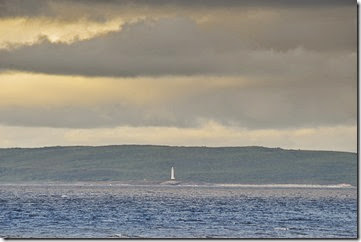 Australia was the passing of the Cape Leeuwin Lighthouse at 34°31'21" S 115°8'17" E. The lighthouse was the last lighthouse in Australia to be automated. This point marks the separation from the Southern Ocean on the right (east) from the Indian Ocean on the left (west).
Australia was the passing of the Cape Leeuwin Lighthouse at 34°31'21" S 115°8'17" E. The lighthouse was the last lighthouse in Australia to be automated. This point marks the separation from the Southern Ocean on the right (east) from the Indian Ocean on the left (west).
Opened with great ceremony by John Forrest in 1895 the lighthouse is located on the headland of Cape Leeuwin the most south-westerly point on the mainland of the Australian Continent, in the state of Western Australia. The young Felix von Luckner, later a German WWI war hero noted for his long voyage on the Seeadler (Sea Eagle) during which he captured 14 enemy ships, was briefly assistant lighthouse keeper, a job he abandoned when discovered with his hotel keeper's daughter by her father.
We reached the port of Freemantle-Perth at about 8:00 am on March 27th. With final cruise bill settled and are luggage gone we were ready disembark for the shuttle to the Perth airport. We had plenty of time to connect with our 2,246 mile Virgin Australia flight to Brisbane then another hop of 862 miles from Brisbane to Cairns. We arrived at our hotel (the Mantra Esplanade) around midnight so there was not much to see and we were tired so we went to bed as would have a busy day starting early in the morning.
Cairns (pronounced “CANS”) is a regional city in the far north of Queensland, Australia, founded 1876. The city was named after William Wellington Cairns, then-current Governor of Queensland. It was formed to serve miners heading for the Hodgkinson River goldfield, but experienced a decline when an easier route was discovered from Port Douglas. It later developed into a railhead and major port for exporting sugar cane, gold and other metals, minerals and agricultural products from surrounding coastal areas and the Atherton Tableland region. As of June 2012, the population is approximately 142,528 and now it is a tourists’ mecca as it the gateway to the Great Barrier Reef.
Our hotel in Cairns was the Mantra Esplanade. The hotel was in a great location on the Esplanade close to the ocean and all of the restaurants.
On Friday morning, March 28th we were up bright add early for our excursion to Kuranda via the Skyrail over the rainforest with a return on the Kuranda Scenic Railway.
Skyrail Rainforest Cableway is a scenic cableway running above the Barron Gorge National Park from the Cairns suburb of Caravonica to Kuranda, Queensland. The development of Skyrail was controversial as some local residents believed that damage may be done to World Heritage listed rainforest. Following seven years of planning and approvals, and 14 months of construction, Skyrail opened to the public in August 1995.
Although you cannot see the bottoms of these rainforest trees they reach as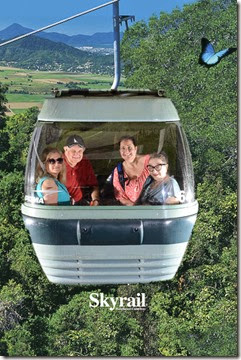 high as 100 meters above the ground.
high as 100 meters above the ground.
Spanning 7.5 kilometers (4.7 mi) over Barron Gorge National Park, the Skyrail experience includes a scenic cableway ride and stops at two rainforest mid-stations. Here, guests alight from the cableway onto rainforest boardwalks, where interpretive information is provided through guided boardwalk tours, signage and an interpretive center.
The rain was ominous, but by the time we arrived in Kuranda the sun came out and it was a fine day.
Kuranda, once a mining town, is now purely a tourist village in the mountains above Cairns. It has many craft stores, cafes, and restaurants. You can buy most anything there from opals (something Australia is famous for), boomerangs, and kangaroo hides to aboriginal jewelry, Australian kangaroo leather hats, and Didgeridoos. There are also several attractions such as the Butterfly Sanctuary, a Bird Sanctuary, and the Kuranda Koala Gardens. Guess where we went? Your right, it was at the Koala Gardens where you could cuddle a koala or hold a snake. No one was interested in hold a snake but the cuddling of a koala was a different matter. Of course my two daughters wanted to cuddle a koala. This time, after the score of Japanese tourists 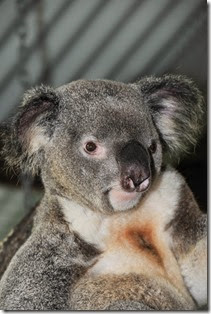 were done with their documentation of the entire family including moms, dads, aunts, uncles, and kids and the translator I was able to get into perfect position to get some great shots of my daughters cuddling the koala. This was unusual as you pay for a commercial photo and many establishments don’t allow you to take your own photos. These folks were very obliging and didn’t care how many photos I took as long as I did not hold up any people waiting in line. I also was able to get some terrific shots of the koalas!
were done with their documentation of the entire family including moms, dads, aunts, uncles, and kids and the translator I was able to get into perfect position to get some great shots of my daughters cuddling the koala. This was unusual as you pay for a commercial photo and many establishments don’t allow you to take your own photos. These folks were very obliging and didn’t care how many photos I took as long as I did not hold up any people waiting in line. I also was able to get some terrific shots of the koalas!
After a session with the wallabies, lunch, and a walk about the town it was time to get to the railway station and board our train and return to Cairns.
The Kuranda Scenic Railway is a name for the railway line that runs from Cairns, Queensland, Australia to the nearby town of Kuranda. The tourist railway snakes its way up the Macalister Range and is no longer used for regular commuter services. It passes through the suburbs of Stratford, Freshwater (stopping at Freshwater Station) and Redlynch before reaching Kuranda. The line is used for some freight services.
Our first stop is Barron Falls where we got out to take a few photos
Barron Falls is where the Barron River makes its descent from the Atherton Tablelands to the Cairns coastal plain. The falls drops 260 meters (853 ft.) in one jump.
Many lives were lost as numerous tunnels and bridges were built. 15 hand-made tunnels and 37 bridges were built to climb from sea level to 328 meters up the Macalister Range. Three million cubic meters of earth had to be excavated during construction.
The first operation of a tourist train from Cairns to Kuranda was in 1936, using four longitudinal seating carriages. In 1995 major repairs had to be carried out after a severe rock fall damaged the track.
On 26 March 2010 the train was derailed by a landslide injuring 5 of the 250 passengers on board. The service was closed until 7 May 2010 while a geotechnical review of the track and risk assessments were completed.
Stony Creek falls where the train makes a 180 degree loop over the bridge. This was the most difficult structure on the line to build.
We finally reached the plains of Cairns and our bus for the return trip to our hotel where we could wash up after battling the humidity, something none of us were accustomed to.
That evening we ventured out on the crowded Esplanade for dinner at my favorite restaurant in Cairns, Barnacle Bill’s. My wife and I had eaten at Barnacle Bill’s nine years ago when we were in Cairns with my brother and sister-in-law. I always remembered the barramundi dinner I had and how delicious it was so we had to return and of course I ordered the barramundi. It was just a good as I remembered. When we mentioned to the waiter that we had been here nine years ago he told the manager and he came over a offered us complementary after dinner drinks. We took him up on his offer and I had a nice glass of port wine. It hit the spot after the barramundi.
On our last day in Cairns we took the Quicksilver tour to their stationary platform at the Agincourt Reef. This would be a fantastic day!
We were bused from our hotel to Port Douglas along the Captain Cook Highway to Port Douglas which is now to jumping off point for the Great Barrier Reef.
Port Douglas is a resort town with a permanent population of 3,201 (2011 census). Port Douglas was No. 3 on Australian Traveler magazine's list of 100 Best Towns In Australia.
The town's population can often double, however, with the influx of tourists during the peak tourism season May–September. The town is named in honor of former Premier of Queensland, John Douglas. Port Douglas developed quickly based on the mining industry.
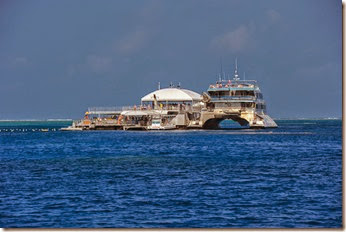 Once we reach the Agincourt Reef we will be offered the opportunities to snorkel, ocean walker helmet dive, scuba diving, or a helicopter flight over the reef. My daughters choose the snorkeling and the ocean walker while Kathy and I opted to the helicopter flight over the reef. If you snorkel or ocean walk you can rent a good underwater digital camera for your photos. As I had my own Nikon AW110 I did not have to rent a camera. The AW110 worked fine in the hands of my daughter.
Once we reach the Agincourt Reef we will be offered the opportunities to snorkel, ocean walker helmet dive, scuba diving, or a helicopter flight over the reef. My daughters choose the snorkeling and the ocean walker while Kathy and I opted to the helicopter flight over the reef. If you snorkel or ocean walk you can rent a good underwater digital camera for your photos. As I had my own Nikon AW110 I did not have to rent a camera. The AW110 worked fine in the hands of my daughter.
We would be traveling to the reef on the Quicksilver V a high speed catamaran that is posh and comfortable. Snacks and limeade were available on the boat and once we reached the platform a hearty hot lunch was served. Quicksilver does a great job and to learn more about what they offer and the prices click here. It is advisable to book your tour ahead of time using the Internet. It is very reliable and is how we did it.
On the way to the Agincourt Reef all arrangements were made for the activity options and the costs taken care of with your credit card. There is a medical questionnaire for those who want to ocean walk or scuba dive. I did not pass the medical test due to my A-Fib condition so I was not able to ocean walk.
Once we reached the Quicksilver platform there was quite a bit of activity as people hustled for their lunch and got ready for their ocean activities. Things are well organized and Quicksilver has all the necessary protective suits, masks, snorkels, flippers, vests, and other items needed for diving. They also have a covey of lifeguards that offer plenty of assistance and safety oversight.
My daughters had a great time snorkeling and ocean walking and took some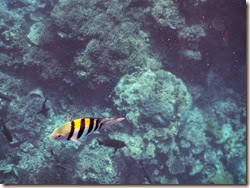 great photos of the coral and aquatic life residing on the reef. Kathy and I were taken to the helicopter pad a bit of a distance from the platform for safety reason where we boarded our modern and plush Bell Jet Ranger for our 15 minute flight over the reef.
great photos of the coral and aquatic life residing on the reef. Kathy and I were taken to the helicopter pad a bit of a distance from the platform for safety reason where we boarded our modern and plush Bell Jet Ranger for our 15 minute flight over the reef.
The Great Barrier Reef can be seen from outer space and is the world's biggest single structure made by living organisms. This reef structure is composed of and built by billions of tiny organisms, known as coral polyps.
It supports a wide diversity of life and was selected as a World Heritage Site in 1981. CNN labeled it one of the seven natural wonders of the world. The Queensland National Trust named it a state icon of Queensland.
A large part of the reef is protected by the Great Barrier Reef Marine Park, which helps to limit the impact of human use, such as fishing and tourism. Other environmental pressures on the reef and its ecosystem include runoff, climate change accompanied by mass coral bleaching, and cyclic population outbreaks of the crown-of-thorns starfish. According to a study published in October 2012 by the Proceedings of the National Academy of Sciences, the reef has lost more than half its coral cover since 1985 .Here you can see the surf breaking over the reef.
Australia has moved northwards at a rate of 7 cm (2.8 in) per year, starting during the Cenozoic Period. Eastern Australia experienced a period of tectonic uplift, which moved the drainage divide in Queensland 400 km (250 mi) inland. Also during this time, Queensland experienced volcanic eruptions leading to central and shield volcanoes and basalt flows. Some of these granitic outcrops have become high islands. After the Coral Sea Basin formed, coral reefs began to grow in the Basin, but until about 25 million years ago, northern Queensland was still in temperate waters south of the tropics—too cool to support coral growth. The Great Barrier Reef's development history is complex; after Queensland drifted into tropical waters, it was largely influenced by reef growth and decline as sea level changed.
Reefs can increase in diameter by 1 to 3 centimeters (0.39 to 1.18 in) per year, and grow vertically anywhere from 1 to 25 cm (0.39 to 9.84 in) per year; however, they grow only above a depth of 150 meters (490 ft.) due to their need for sunlight, and cannot grow above sea level.
The Reef Research Centre, a Cooperative Research Centre, has found coral skeleton' deposits that date back half a million years. The Great Barrier Reef Marine Park Authority (GBRMPA) considers the earliest evidence of complete reef structures to have been 600,000 years ago.
According to the Great Barrier Reef Marine Park Authority (GBRMPA), the current, living reef structure is believed to have begun growing on the older platform about 20,000 years ago. The Australian Institute of Marine Science agrees, placing the beginning of the growth of the current reef at the time of the Last Glacial Maximum. At around that time, sea level was 120 meters (390 ft.) lower than it is today.
Shipping accidents are a pressing concern, as several commercial shipping routes pass through the Great Barrier Reef. Although the route through the Great Barrier Reef is not easy, reef pilots consider it safer than outside the reef in the event of mechanical failure, since a ship can sit safely while being repaired. There have been over 1,600 known shipwrecks in the Great Barrier Reef region. On 3 April 2010, bulk coal carrier Shen Neng 1 ran aground on Douglas Shoals, spilling up to four tones of oil into the water and causing extensive damage to the reef.
Of all the places I have travelled to in my life I found the visit to the Great Barrier Reef to be the most entertaining, fun, and memorable. Quicksilver does a excellent job and offers great value. I highly recommend them. If you are ever in Australia hop a flight to Cairns for a few days and visit the reef. It is advisable to book your tour ahead of time at http://www.quicksilver-cruises.com/wavepiercer.htm
Here are the per person adult costs for a Quicksilver trip to the reef. The basic fare that includes lunch and on-board snacks is: $225.
-
Introductory Snorkeling Tour with Marine Biologist: $56.
-
Advanced Snorkeling Tour with Marine Biologist: $74.
-
Ocean Walker helmet diving: $158.
-
Helicopter flight $165.
-
Round trip coach transfer from Cairns to Port Douglas and back: $28.
-
Rental of an underwater digital camera $69.
All prices are in Australian dollars which today are at $0.94 for 1 AUS Dollar. This may seem a bit pricy, but it’s a once in a lifetime experience you will never forget
What more can I say about the beauty and magnificence of this place. I agree with CNN in calling it one of the wonders of the natural world. It ranks right up there with the Grand Canyon and Iguaçu and Niagara Falls.
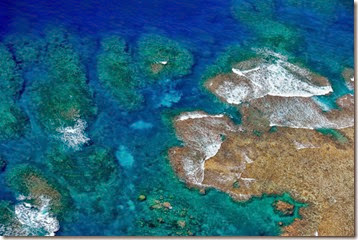 Above the reef at 1,297 feet the apogee point of our flight. I took this shot with a GPS equipped Nikon D700 using a 28-300 mm f/3.5-5.6 zoom lens. Or this shot the zoom was set to 116mm and the exposure was 1/1000 at f8.0 using an ISO of 400. I used a fast shutter speed to compensate for the movement of the helicopter.
Above the reef at 1,297 feet the apogee point of our flight. I took this shot with a GPS equipped Nikon D700 using a 28-300 mm f/3.5-5.6 zoom lens. Or this shot the zoom was set to 116mm and the exposure was 1/1000 at f8.0 using an ISO of 400. I used a fast shutter speed to compensate for the movement of the helicopter.
After a great day at the Great Barrier Reef we returned to Cairns and the Esplanade for a good German dinner at the Bavarian Beerhouse. . The proprietor is a relocated German to Australia. His food and beer is good and authentic. Nothing like a schnitzel and a good glass of German beer to top off a great day.. Cairns is well worth a visit if you are ever in Australia.
The cruise was great, but a bit too long on a big ship with more people than I liked. Royal Caribbean did a great job even though the weather was a bit testy. Of all the shore excursions I rate The Great Barrier Reef No. 1, Kuranda and the rainforest No. 2, and the New Zealand Kiwi Orchard No. 3. Last on my list was the excursion to Napier with its aquarium and winery.
As in all travel articles I will close with a picture of a sunset. This particular sunset took place over Hauraki Gulf at 17:43 local time at 36°36'33" S 174°57'55" E, 21 miles NE of Auckland, New Zealand.
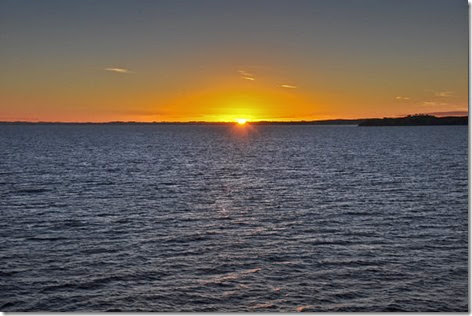
I realize this was a long blog post with numerous links to photos. I took over 2,400 digital photos and culled that down to the 1,087 I have posted on SmugMug. I hope you enjoyed the photos and the narrative.
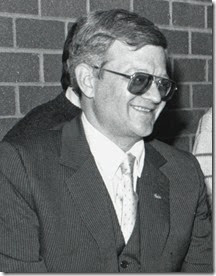 Present Danger foretold the U.S. involvement in the drug wars in Colombia and his 1994 Debt of Honor predicted an airliner used as a guided missile crashing into the Capital Building — seven years before September 11, 2001.
Present Danger foretold the U.S. involvement in the drug wars in Colombia and his 1994 Debt of Honor predicted an airliner used as a guided missile crashing into the Capital Building — seven years before September 11, 2001. which is why, after its residents voted in favor of annexation, Putin approvingly noted that "after a long, difficult, exhausting voyage, Crimea and Sevastopol are returning to their native harbor, to their native shores, to their port of permanent registration -- to Russia." By contrast, the case to reach out to Transnistria in Moldova, for example, or even eastern Ukraine, is less clear. The Transnistrian Russians are relatively new colonists, arriving after World War II, and eastern Ukraine has Russian cities, but also a Catholic, Ukrainian countryside.”








![Over 70% of kiwi production is in Italy, New Zealand, and Chile. Italy produces roughly 10% more kiwifruit than New Zealand, and Chile produces 40% less.[3] With these three main production centers, kiwifruit is produced for worldwide consumption roughly all year long Over 70% of kiwi production is in Italy, New Zealand, and Chile. Italy produces roughly 10% more kiwifruit than New Zealand, and Chile produces 40% less.[3] With these three main production centers, kiwifruit is produced for worldwide consumption roughly all year long](http://lh3.ggpht.com/-JoFoEQrA7S0/U1dT39xwARI/AAAAAAAAFF0/G0R60F7An1w/FXP_9213%25255B5%25255D.jpg?imgmax=800)
















